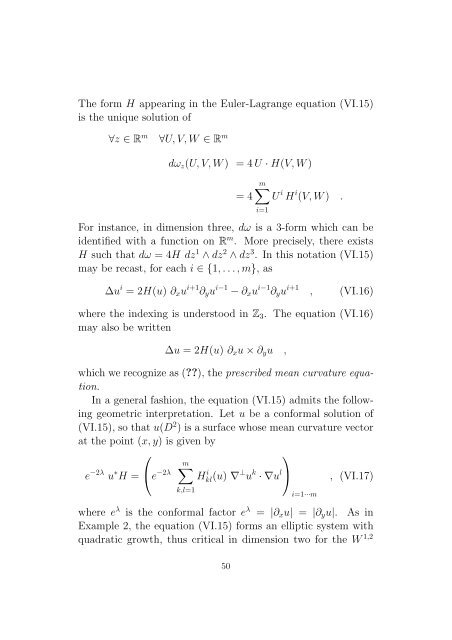Conformally Invariant Variational Problems. - SAM
Conformally Invariant Variational Problems. - SAM
Conformally Invariant Variational Problems. - SAM
You also want an ePaper? Increase the reach of your titles
YUMPU automatically turns print PDFs into web optimized ePapers that Google loves.
The form H appearing in the Euler-Lagrange equation (VI.15)<br />
is the unique solution of<br />
∀z ∈ R m ∀U,V,W ∈ R m<br />
dω z (U,V,W) = 4U ·H(V,W)<br />
= 4<br />
m∑<br />
U i H i (V,W) .<br />
For instance, in dimension three, dω is a 3-form which can be<br />
identified with a function on R m . More precisely, there exists<br />
H such that dω = 4H dz 1 ∧dz 2 ∧dz 3 . In this notation (VI.15)<br />
may be recast, for each i ∈ {1,...,m}, as<br />
i=1<br />
∆u i = 2H(u) ∂ x u i+1 ∂ y u i−1 −∂ x u i−1 ∂ y u i+1 ,<br />
(VI.16)<br />
where the indexing is understood in Z 3 . The equation (VI.16)<br />
may also be written<br />
∆u = 2H(u) ∂ x u×∂ y u ,<br />
which we recognize as (??), the prescribed mean curvature equation.<br />
In a general fashion, the equation (VI.15) admits the following<br />
geometric interpretation. Let u be a conformal solution of<br />
(VI.15), so that u(D 2 ) is a surface whose mean curvature vector<br />
at the point (x,y) is given by<br />
⎛<br />
⎞<br />
∑ m<br />
e −2λ u ∗ H = ⎝e −2λ Hkl i (u) ∇⊥ u k ·∇u l ⎠ , (VI.17)<br />
k,l=1<br />
i=1···m<br />
where e λ is the conformal factor e λ = |∂ x u| = |∂ y u|. As in<br />
Example 2, the equation (VI.15) forms an elliptic system with<br />
quadratic growth, thus critical in dimension two for the W 1,2<br />
50
















